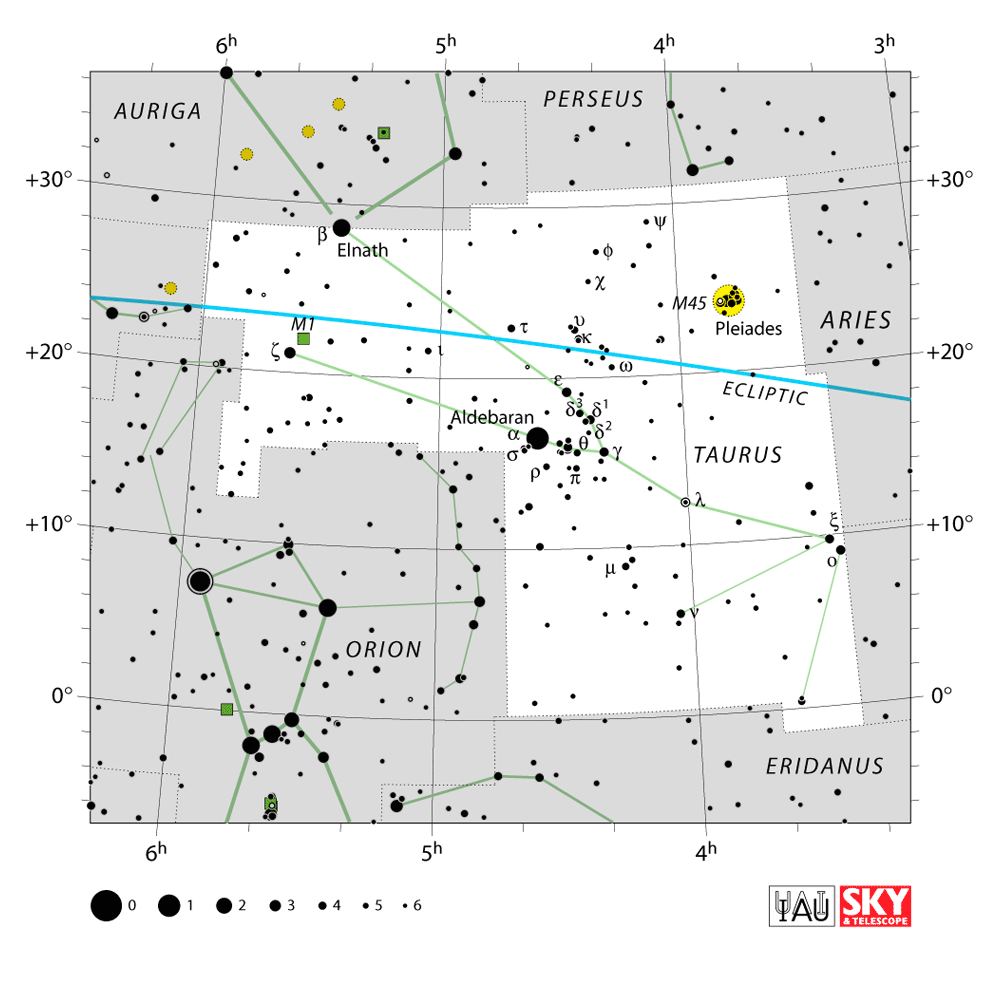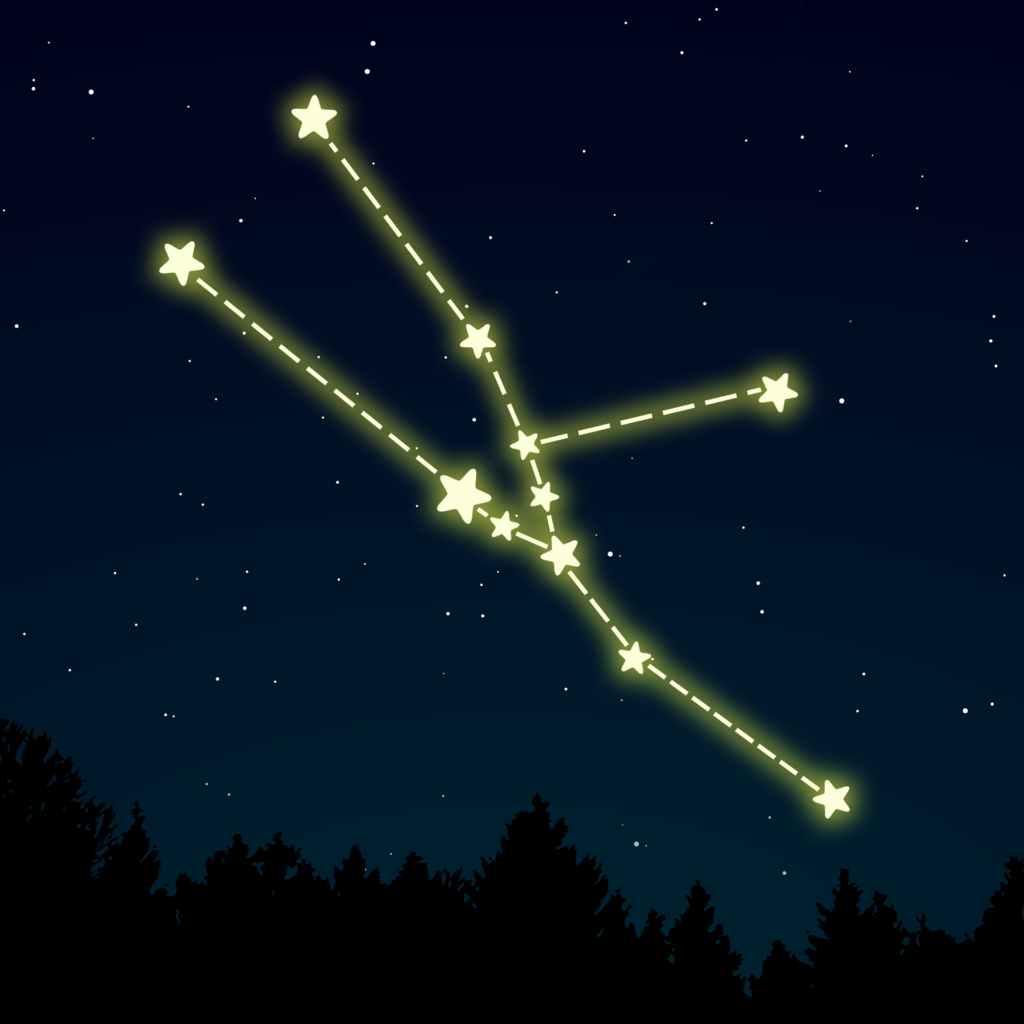Stargazing with Taurus
© freepik/tartila
Table of Contents
Taurus, an officially recognized constellation, holds a rich tapestry of ancient myths and celestial allure. Its name, derived from the Latin word for bull, is deeply intertwined with the legendary tale of Zeus assuming the form of a magnificent bull to carry off Europa, a Phoenician princess. This constellation is among the oldest, with roots tracing back to at least the Early Bronze Age, serving as a marker for the spring equinox. Its significance in agricultural calendars left an indelible mark on the mythologies of diverse ancient civilizations, including Sumer, Akkad, Assyria, Babylon, Egypt, Greece, and Rome, where various bull-related figures held cultural importance.
This constellation is situated in the northern celestial hemisphere, positioned between the constellations Aries to the west and Gemini to the east; to the north lies Perseus and Auriga, to the southeast Orion, to the south Eridanus, and the southwest Cetus.
Taurus, as a zodiacal constellation, intersects with the ecliptic – the apparent path the Sun traces across the celestial sphere during Earth‘s yearly orbit. This positioning means that, at various points throughout the year, the Moon and planets often pass through Taurus. Furthermore, Taurus holds a unique celestial distinction: it is the only constellation crossed by all three major reference planes – the galactic equator, celestial equator, and ecliptic. Notably, Gould’s Belt, a ring-like galactic structure, traverses through Taurus.
Within Taurus lie two of the most renowned star clusters in the night sky: the Pleiades, also known as the Seven Sisters, and the Hyades. Aldebaran, the brightest star in Taurus, shines as the fiery eye of the celestial bull. The northern part of Taurus encompasses the Taurus-Auriga complex, one of the closest active star-forming regions. Additionally, T Tauri, a variable star, stands as the archetype for a class of pre-main-sequence stars.
HISTORY OF TAURUS

The Taurus constellation holds a rich history intertwined with ancient mythology and cultural significance. Its origins can be traced back thousands of years to early civilizations like the Sumerians and Babylonians. In their cosmology, Taurus was often associated with the goddess Inanna, who was symbolically linked to a great bull. This celestial connection played a role in their religious beliefs and practices, influencing aspects of their society.
In Greek mythology, Taurus is famously associated with the tale of Zeus, who transformed himself into a bull to seduce and abduct Europa, a Phoenician princess. This iconic story helped solidify the bull’s representation in the night sky. The constellation’s name itself, “Taurus,” stems from the Latin word for bull.
Taurus’ celestial prominence was further solidified by the ancient Egyptians, who saw the bull as a symbol of strength and fertility. They identified Taurus with the god Hathor, who was often depicted with the horns of a cow. Additionally, the veneration of Apis, a sacred bull deity, was an integral part of their religious practices.
The association of Taurus with celestial events and agricultural cycles was also prevalent in various cultures. For instance, the rising of Taurus in the east marked the beginning of the agricultural season in ancient Greece. This connection between the constellation and earthly activities contributed to its cultural significance.
Over the centuries, Taurus remained an important point of reference for navigators and early astronomers. Its stars were used for navigation, particularly Aldebaran, the bright red star that represents the bull’s eye. Aldebaran’s distinctive colour and visibility made it a key celestial marker.
ASTRONOMICAL FEATURES

The Taurus constellation boasts several notable astronomical features, including prominent stars, star clusters, and nebulae.
ALPHA TAURI
Aldebaran, also known as Alpha Tauri, stands as the most luminous beacon in the Taurus constellation. Positioned approximately 65 light-years away from our planet, it emits a distinctive orange glow, rendering it easily distinguishable against the backdrop of the night sky. This colossal celestial entity surpasses our Sun in size by a factor of 44 and outshines it in luminosity by over 400 times. Its name, originating from Arabic roots, translates to “the follower,” a testament to its apparent trailing of the Pleiades star cluster – a prominent feature within Taurus. Often hailed as the “eye of the bull,” Aldebaran serves as a prominent guidepost for both avid stargazers and dedicated astronomers.
THE PLEIADES
The Pleiades, also known as M45, is a mesmerizing open star cluster nestled within the Taurus constellation. Comprising several young, hot stars, it is one of the most recognizable celestial objects in the night sky. Visible to the naked eye, the Pleiades appear as a tight grouping of stars, often likened to a miniature dipper. This cluster holds immense cultural and mythological significance across various civilizations, earning it various names and legends. Located approximately 444 light-years away from Earth, the Pleiades continue to captivate astronomers and stargazers, serving as a stunning testament to the beauty and wonder of the cosmos.
THE HYADES
The Hyades, also known as Melotte 25, is a prominent open star cluster situated within the boundaries of the Taurus constellation. This cluster forms the distinctive “V” shape that represents the head of the celestial bull. It is one of the closest open clusters to Earth, located approximately 153 light-years away. Comprising a mix of young and evolved stars, the Hyades cluster showcases a diverse range of stellar stages. Due to its proximity, some of its stars appear to be moving together through space. This makes the Hyades a valuable subject for astronomers studying stellar dynamics and evolution. It remains a captivating feature in the Taurus constellation, drawing the attention of both amateur stargazers and professional researchers.
CRAB NEBULA
The Crab Nebula, designated as M1 in the Messier catalogue, is a spectacular celestial object located in the Taurus constellation. It is the remnant of a supernova explosion that was observed by Chinese astronomers in 1054 AD. Situated approximately 6,500 light-years away from Earth, the Crab Nebula is one of the most studied and photographed remnants of a stellar explosion. It exhibits a complex structure of expanding gas and high-energy particles, including a rapidly spinning neutron star at its center, known as the Crab Pulsar. This fascinating nebula serves as a window into the violent and transformative events that shape the cosmos.
NGC 1647
NGC 1647 is a captivating open star cluster located in the Taurus constellation. Situated roughly 2,200 light-years away from Earth, this cluster is a stunning celestial sight that can be observed with binoculars or a small telescope. It is composed of a group of relatively young stars, thought to have formed together from the same molecular cloud. The arrangement of stars in NGC 1647 creates a picturesque scene against the backdrop of the cosmic expanse. This cluster is a popular target for amateur astronomers and stargazers looking to appreciate the beauty and diversity of celestial objects within our galaxy.
NGC 1746
NGC 1746 is an intriguing open star cluster nestled in the eastern part of the Taurus constellation. Located approximately 6,500 light-years away from Earth, this cluster is a captivating celestial formation. It comprises a group of young stars that formed from the same molecular cloud, creating a visually striking arrangement against the cosmic backdrop. While not as well-known as some other celestial objects, NGC 1746 offers a rewarding sight for amateur astronomers and stargazers with telescopic equipment, providing a glimpse into the intricate dynamics of star formation and galactic evolution.
TAURUS MOLECULAR CLOUDS
The Taurus Molecular Clouds are extensive regions of interstellar gas and dust located in the Taurus constellation. Situated approximately 400 light-years away from Earth, these clouds are known for their rich concentration of star-forming material. Within these molecular clouds, dense pockets of gas and dust collapse under their own gravity, giving birth to new stars. Notable star-forming regions like the Taurus-Auriga complex are embedded within these clouds, hosting young stellar clusters and protostellar objects. The Taurus Molecular Clouds provide a fertile ground for astronomers to study the processes of star formation and gain insights into the early stages of stellar evolution.
ZETA TAURI
Zeta Tauri, also known as Tianguan, is a binary star system located near the tip of the eastern horn of the Taurus constellation. It is approximately 440 light-years away from Earth. The primary star in this system is a hot, blue giant, while the secondary star is a fainter companion. Zeta Tauri serves as a useful navigational reference point for astronomers and stargazers, adding to the celestial landscape of the Taurus constellation.
VISIBILITY AND SEASONALITY

The visibility and seasonality of the Taurus constellation offer a dynamic interplay between the night sky and Earth’s orbit. Depending on one’s location and the time of year, Taurus reveals itself with varying degrees of prominence. Understanding when and where to look for this celestial bull can enhance the stargazing experience, providing insights into the cyclical rhythms of the cosmos.
NORTHERN HEMISPHERE
- Winter: Taurus is most prominent during the winter months, starting in November. It rises in the east and is well-placed for observation in the evening sky.
- Spring: As spring progresses, Taurus moves towards the western horizon. By late spring, it becomes less visible and eventually sets in the west.
- Summer: Taurus is not typically visible in the summer months for Northern Hemisphere observers, as it is below the horizon during nighttime.
- Autumn: Taurus begins to rise in the east again, becoming more visible in the late evening. It continues to be well-placed for observation throughout the fall.
SOUTHERN HEMISPHERE
- Summer: Taurus is visible in the early evening sky during the summer months. It rises in the east and is best observed in the late evening.
- Autumn: As autumn progresses, Taurus moves towards the western horizon. By late autumn, it becomes less prominent and eventually sets in the west.
- Winter: Taurus is not typically visible in the winter months for Southern Hemisphere observers, as it is below the horizon during nighttime.
- Spring: Taurus begins to rise in the east again, becoming more visible in the late evening. It continues to be well-placed for observation throughout the spring.
METEOR SHOWER

The Taurid meteor shower is an annual celestial event characterized by a relatively low but steady stream of meteors appearing to emanate from the direction of the Taurus constellation, particularly near the stars Aldebaran and the Pleiades. This meteor shower is divided into two streams: the South Taurids and the North Taurids.
- South Taurids: Active from late September to early December, the South Taurids are known for producing bright and slow-moving meteors. While their peak activity is typically around late October and early November, the South Taurids are known for having a prolonged period of consistent meteor activity.
- North Taurids: These meteors are active from late October through early December, with their peak occurring around mid-November. The North Taurids are known for producing fewer meteors compared to the South Taurids, but they often exhibit even brighter and more spectacular fireballs.
The Taurid meteor shower is distinctive in that it tends to produce a higher proportion of fireballs—extremely bright meteors that can light up the night sky with a brilliant burst of light. This characteristic makes the Taurids a favourite among meteor enthusiasts and astrophotographers.
The origin of the Taurid meteor shower is associated with Comet 2P/Encke, which is believed to be the parent body responsible for depositing the debris that Earth passes through during this annual event. The Taurid complex also includes several other related meteor showers, including the Beta Taurids.
While the Taurids may not produce the same high meteor rates as some other showers like the Perseids or Geminids, their fireballs and prolonged activity make them a unique and exciting event for those interested in observing meteors. Additionally, due to their lower activity, the Taurids are less affected by moonlight, making them an excellent meteor shower to observe under a dark sky.
